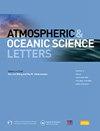Impacts of meteorological conditions on the NASM pollution data assimilation system
IF 3.2
4区 地球科学
Q3 METEOROLOGY & ATMOSPHERIC SCIENCES
引用次数: 0
Abstract
Since meteorological conditions are the main factor driving the transport and dispersion of air pollutants, an accurate simulation of the meteorological field will directly affect the accuracy of the atmospheric chemical transport model in simulating PM2.5. Based on the NASM joint chemical data assimilation system, the authors quantified the impacts of different meteorological fields on the pollutant simulations as well as revealed the role of meteorological conditions in the accumulation, maintenance, and dissipation of heavy haze pollution. During the two heavy pollution processes from 10 to 24 November 2018, the meteorological fields were obtained using NCEP FNL and ERA5 reanalysis data, each used to drive the WRF model, to analyze the differences in the simulated PM2.5 concentration. The results show that the meteorological field has a strong influence on the concentration levels and spatial distribution of the pollution simulations. The ERA5 group had relatively small simulation errors, and more accurate PM2.5 simulation results could be obtained. The RMSE was 11.86 μg m−3 lower than that of the FNL group before assimilation, and 5.77 μg m−3 lower after joint assimilation. The authors used the PM2.5 simulation results obtained by ERA5 data to discuss the role of the wind field and circulation situation on the pollution process, to analyze the correlation between wind speed, temperature, relative humidity, and boundary layer height and pollutant concentrations, and to further clarify the key formation mechanism of this pollution process.
摘要
气象条件对于污染物的累积, 清除, 传输和扩散有关键的作用. 本文将分别使用FNL 和ERA5再分析资料作为天气模式WRF的初始场, 基于构建的联合数据同化系统, 定量评估气象场对模拟PM2.5浓度的作用, 同时揭示不同气象要素对于污染物积累, 维持和消散的影响. 研究表明ERA5资料在各个区域的污染模拟结果更接近观测值, 分析了风速, 温度, 相对湿度以及边界层高度与污染物浓度之间的相关性, 并进一步阐明污染过程的形成机制.

气象条件对NASM污染资料同化系统的影响
由于气象条件是驱动大气污染物输送和扩散的主要因素,对气象场的准确模拟将直接影响大气化学输送模式模拟PM2.5的准确性。基于NASM联合化学资料同化系统,量化了不同气象场对污染物模拟的影响,揭示了气象条件在重霾污染积累、维持和消散中的作用。在2018年11月10日至24日两次重污染过程中,利用NCEP FNL和ERA5再分析数据获取气象场,分别用于驱动WRF模型,分析模拟PM2.5浓度的差异。结果表明,气象场对污染模拟的浓度水平和空间分布有较大的影响。ERA5组的模拟误差相对较小,可以获得更准确的PM2.5模拟结果。同化前RMSE比FNL组低11.86 μ m−3,联合同化后RMSE比FNL组低5.77 μ m−3。利用ERA5数据获得的PM2.5模拟结果,探讨风场和环流情况对污染过程的作用,分析风速、温度、相对湿度、边界层高度与污染物浓度的相关性,进一步阐明该污染过程的关键形成机制。摘要气象条件对于污染物的累积, 清除, 传输和扩散有关键的作用. 本文将分别使用新兵和ERA5再分析资料作为天气模式WRF的初始场,基于构建的联合数据同化系统,定量评估气象场对模拟PM2.5浓度的作用,同时揭示不同气象要素对于污染物积累,维持和消散的影响。研究表明ERA5资料在各个区域的污染模拟结果更接近观测值,分析了风速,温度,相对湿度以及边界层高度与污染物浓度之间的相关性,并进一步阐明污染过程的形成机制。
本文章由计算机程序翻译,如有差异,请以英文原文为准。
求助全文
约1分钟内获得全文
求助全文
来源期刊

Atmospheric and Oceanic Science Letters
METEOROLOGY & ATMOSPHERIC SCIENCES-
CiteScore
4.20
自引率
8.70%
发文量
925
审稿时长
12 weeks
 求助内容:
求助内容: 应助结果提醒方式:
应助结果提醒方式:


